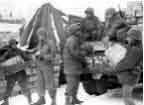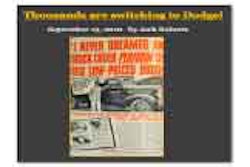The greatest story (almost) never told

Much has been written in CCJ about the critical role trucks played during World War II. But one fascinating story that somehow escaped editors’ attention at the time came to light in our research for this 100th anniversary issue. A massive U.S. Army Transportation Corps operation in northern France – codenamed the “Red Ball Express” – delivered gasoline, munitions, rations and other supplies to front-line troops during an 82-day campaign between August and November 1944.
Wanting to know more, I spoke with former U.S. Army Staff Sgt. Homer McCraw Sr. – a Red Ball Express veteran – over the phone from his home in Huntsville, Ala., to get a firsthand account of daily life in the massive supply operation. Now 90 years old, McCraw looks back on his role with great humility but understands the importance of supplying infantry troops on the front line.
 Red Ball Express drivers load supplies to deliver to troops on the front line.
Red Ball Express drivers load supplies to deliver to troops on the front line.“They couldn’t be firing if we didn’t put it there for them – they’d tell us what they need, and we’d get it to them,” says McCraw in a simple summary of an operation that was anything but.
The Red Ball Highway – so named for the signs and buildings painted with a red circle to mark the route – stretched nearly 400 miles from the U.S. Army supply depot near Omaha Beach to the First Army and Patton’s Third Army positions along the borders of Belgium and Luxembourg. According to reports, 75 percent of Red Ball Express drivers were black, as the U.S. Army at the time relegated most black troops to noninfantry assignments.
McCraw, a platoon leader in the 3393 Quartermaster Truck Co., was responsible for a convoy of eight six-wheel GMC trucks. Armed with only pistols and M1 carbine semi-automatic rifles, McCraw’s company would set out on roundtrip missions that took more than 50 hours primarily on dirt roads.
“We mainly traveled under the cover of darkness,” recalls McCraw. “We were told we were covered alright,” but he says if there was air support above the convoy, you sure couldn’t hear it.
Nighttime driving brought a new set of risks. Truck headlights were fitted with “cat eye” covers that reduced the beam’s intensity to conceal convoys from German bombers. “We could barely see the truck in front of us,” says McCraw. Nighttime speeds were reduced to 25 mph, and the standard 60-yard interval between trucks was shortened so drivers wouldn’t get lost.
Driver fatigue was another concern, so the Army began using team drivers over long hauls. “They added substitute drivers because there were more accidents when it was just one driver per truck,” says McCraw.
Nearly indefensible from German bomber and mortar attacks, driver casualties were not uncommon. “But not in the second platoon – that was my platoon – I didn’t lose anybody,” says McCraw.
McCraw did have one close call when a German mortar shell struck a tree as his lead Jeep passed underneath. An exploding limb struck his helmet and snapped his tooth out. There must be other stories, however, as McCraw was awarded both the Silver Star for valor in the face of the enemy and the Bronze Star.
McCraw’s driving duties took him all over Europe as the war wore to an end. I asked if he considered a career in trucking afterward. “Oh no,” he laughed. “I’d had enough of that.” McCraw graduated from Alabama A&M University and had a lifelong career in education.
When Allied troops pushed further east across Belgium and into Germany, the Red Ball Express ended as new supply routes were established. By the end of the three-month operation, the Red Ball Express had delivered nearly 500,000 tons of supplies and was quite literally the artery that kept the heart of the Allied armies pumping in the critical months after D-Day. After decades of demonstrating its reliability at home, the motor truck now had proven its worth on the world’s largest stage.
Jeff Crissey is Editor of Commercial Carrier Journal.
E-mail [email protected] or call (205) 248-1244.











